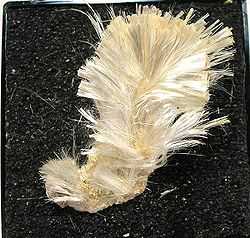Halotrichite
| Halotrichite | |
|---|---|
|
A sample of Halotrichite | |
| General | |
| Category | Sulfate minerals |
| Formula (repeating unit) | FeAl2(SO4)4·22H2O. |
| Strunz classification | 07.CB.85 |
| Crystal symmetry |
Monoclinic sphenoidal H-M symbol: (2) Space group: P 2 |
| Unit cell | a = 20.51 Å, b = 24.29 Å, c = 6.18 Å; β = 100.99°; Z=4 |
| Identification | |
| Color | Colorless to white, yellowish, greenish |
| Crystal habit | Acicular to asbestiform clusters, incrustations and efflorescences |
| Crystal system | Monoclinic |
| Cleavage | Poor on {010} |
| Fracture | Conchoidal |
| Tenacity | Brittle |
| Mohs scale hardness | 1.5 - 2 |
| Luster | Vitreous |
| Diaphaneity | Transparent, translucent |
| Specific gravity | 1.89 |
| Optical properties | Biaxial (-) |
| Refractive index | nα = 1.480 nβ = 1.486 nγ = 1.490 |
| Birefringence | δ = 0.010 |
| 2V angle | Measured: 35° |
| Solubility | Soluble in water |
| Other characteristics | Astringent taste |
| References | [1][2][3] |
Halotrichite, also known as feather alum, is a highly hydrated sulfate of aluminium and iron. Its chemical formula is FeAl2(SO4)4·22H2O. It forms fibrous monoclinic crystals. The crystals are water soluble.
It is formed by the weathering and decomposition of pyrite commonly near or in volcanic vents. Occurrences include the Atacama Desert, Chile, Dresden, Saxony, Germany, San Juan County, Utah, Iceland, and Mont Saint-Hilaire, Canada.
The name is from Latin: halotrichum for salt hair.[3]

Halotrichite from California

Halotrichite from the abandoned Golden Queen mine on Soledad Mountain south of Mojave, California
